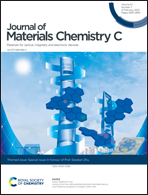The prospects of organic semiconductor single crystals for spintronic applications
Abstract
Organic semiconductor single crystals (OSSCs) possess high mobility and ultra-long spin relaxation times in the millisecond or even second range, mainly due to their pure material systems, perfect periodic structures, and inherent weak spin–orbit coupling (SOC). Coupling this with their excellent photoelectric functionality, they have long been considered as perfect materials for organic spintronic applications to obtain both long-distance spin transport and novel multifunctionality at room temperature, attracting wide interest. Currently, spintronic studies based on OSSCs are still at the heuristic stage, and there are many related critical challenges, as well as important opportunities. Herein, this perspective article, relying on developed theory and in-depth investigations of organic semiconductors (OSCs) in electronics and spintronics, provides discussion and future prospects, focusing on several aspects of OSSCs; we aim to inspire progress in this new field and attempt to guide a wide range of research in related fields. Firstly, as the spin relaxation time and charge carrier mobility are the two main factors affecting the spin diffusion length, the effects of the molecular structure and stacking structure regarding these two factors are discussed, covering material design and regulation methods in detail. Then, the current situation and challenges relating to device fabrication technology based on OSSCs are outlined, highlighting what needs to be solved in order to build a foundation for achieving extra-long spin transport in OSSCs and novel multifunctional OSSC-based spintronic devices. Finally, based on various reported multifunctional spintronic devices and OSSCs with excellent photoelectric properties, the exploitation of novel multifunctional spintronic devices is discussed.

- This article is part of the themed collection: Special issue in honour of Daoben Zhu


 Please wait while we load your content...
Please wait while we load your content...